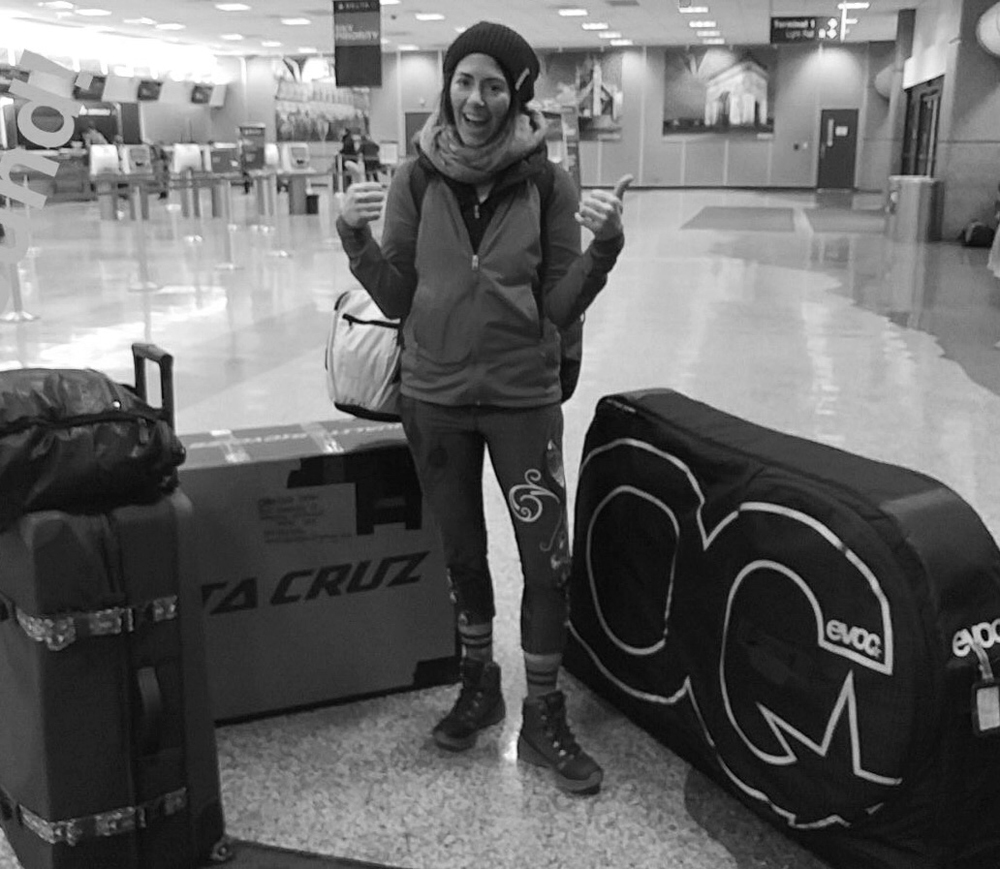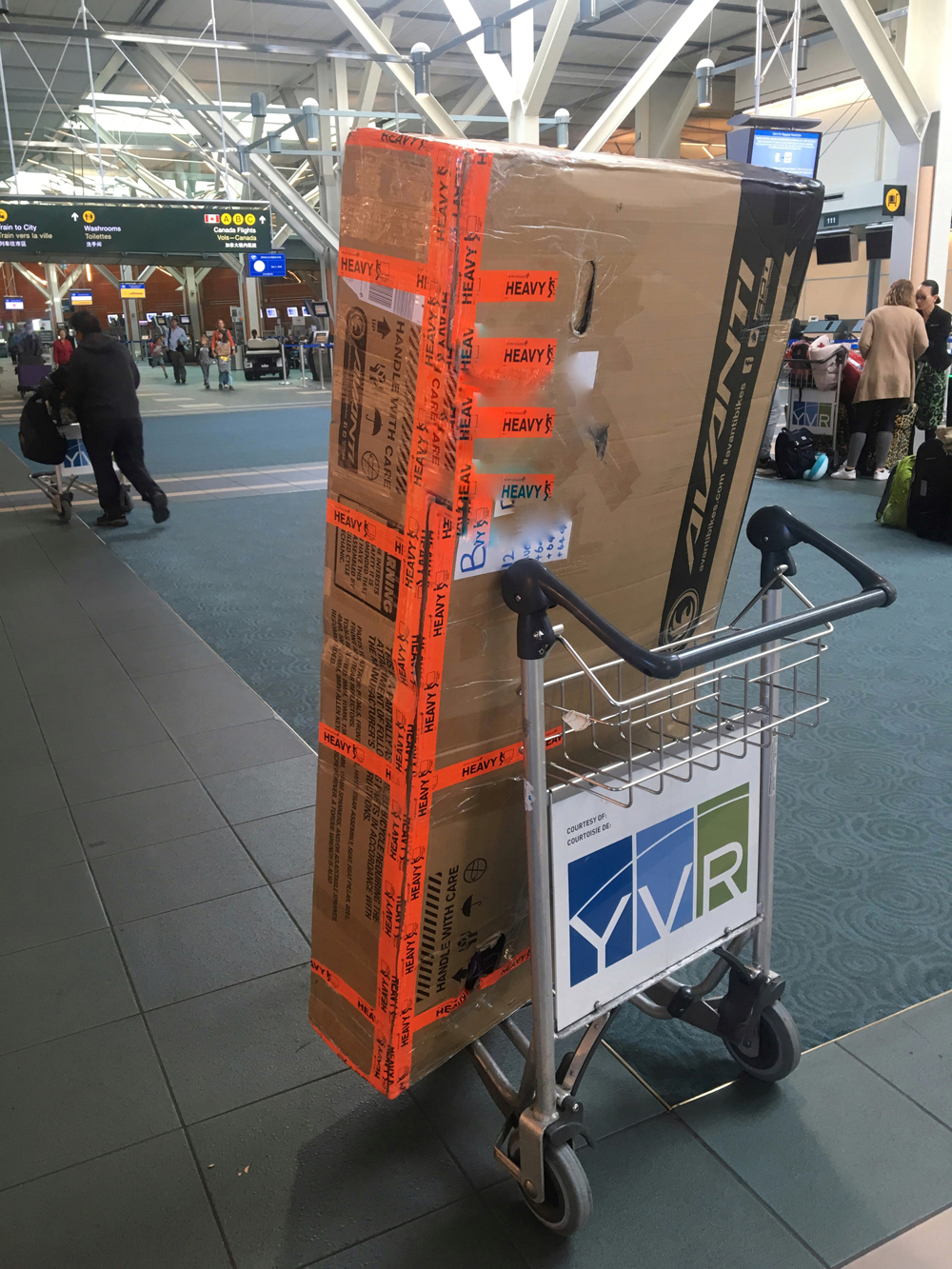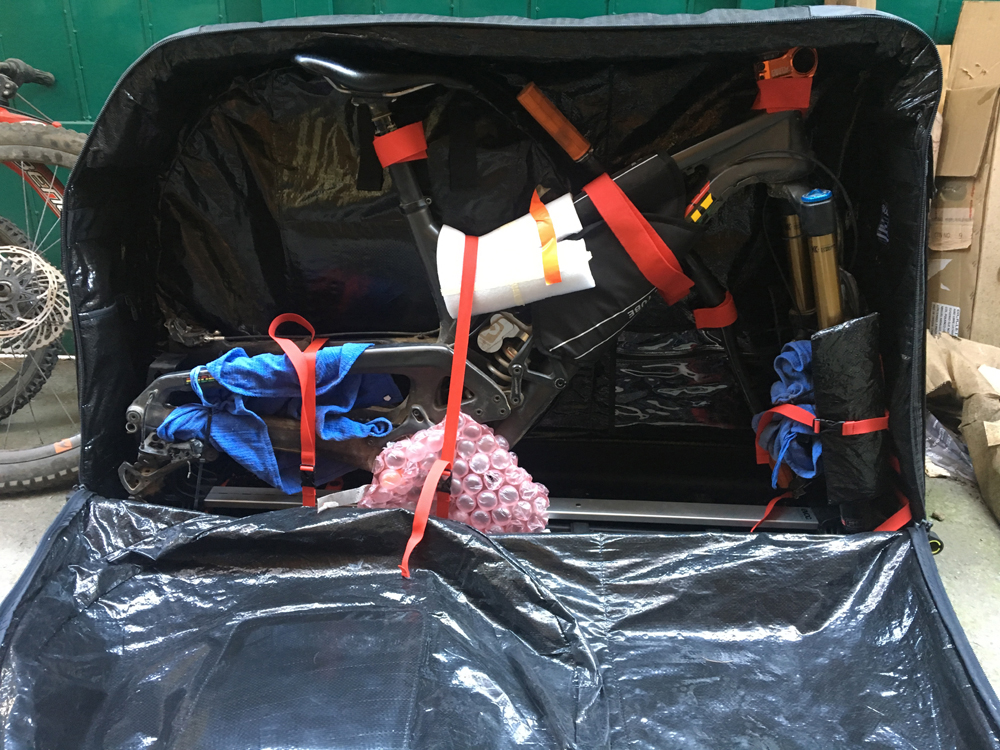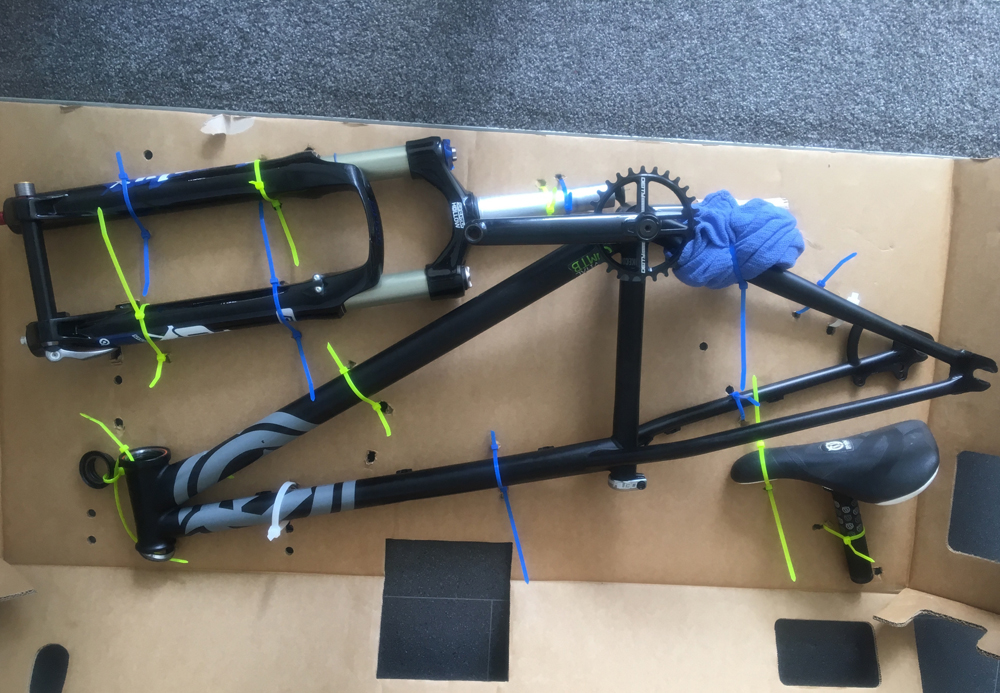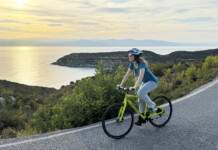By Christine Dern — So your brave adventurous soul has decided to venture outside the USA to mountain bike. Exciting!! Whether this is your first time or you are a seasoned traveler, here are some simple things to consider to make your traveling experience flow as smoothly as your mountain bike will flow over that international dirt.
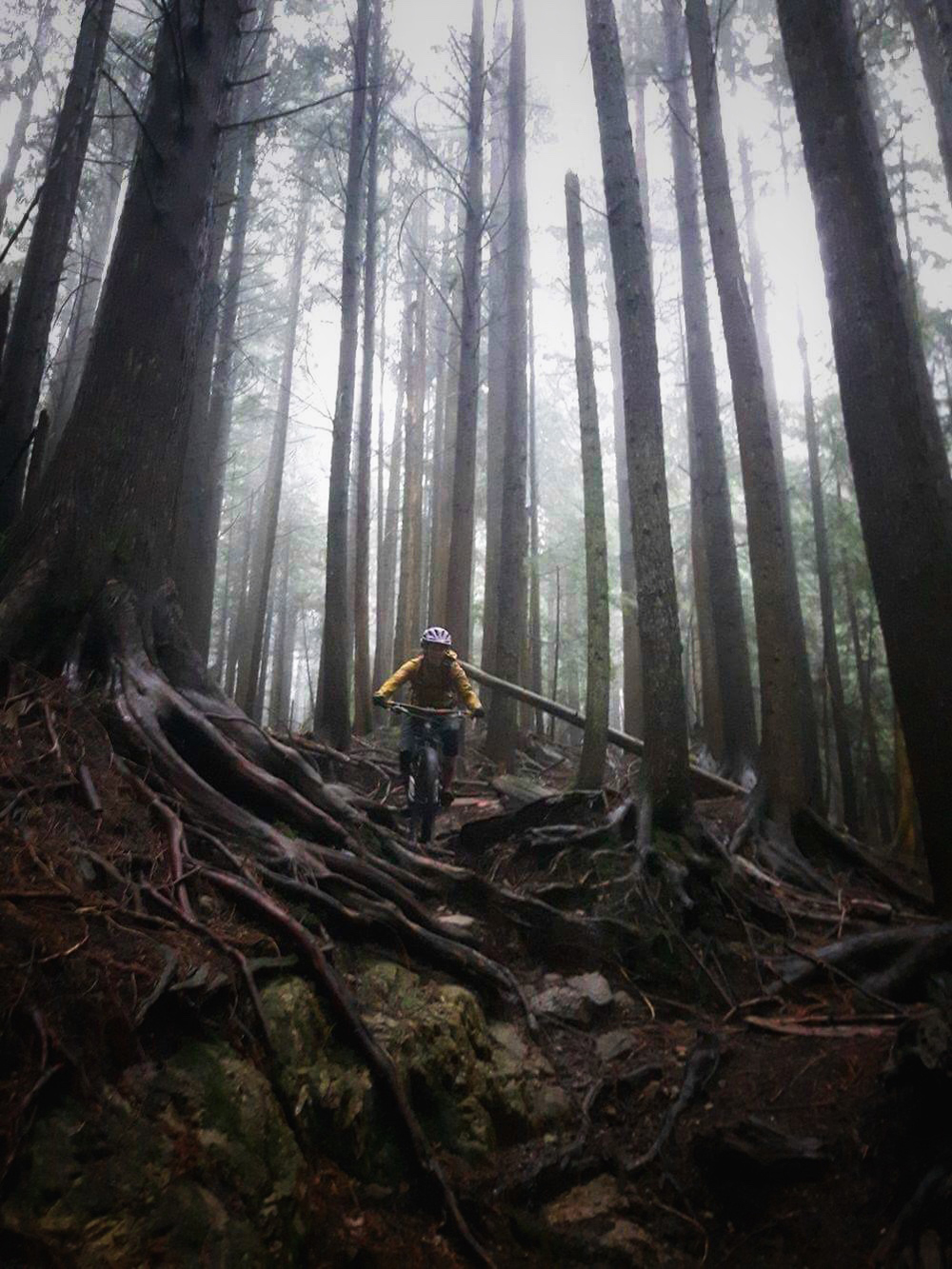
I have found the secret to easy traveling is a little pre-planning. This seems like a lot of work initially but I assure you it isn’t as bad as it seems and doing it all prior to departing is much easier than once you arrive at your destination… or are stuck at the airport rearranging. Prior proper planning can make a huge difference in how the trip unfolds so check them off as you go and let my anxiety induced last minute packing moments reduce yours.
Passport
First things first… your passport! Think of it like your passport to adventure and far off lands… either find yours, get one, make sure it is still valid and never let it expire again.
Visa
Some countries require a visa for visiting or for extended stays and working. This can easily be found via a quick google search or by visiting your destination country’s immigration site. Most of these are either not required or can be done online with a quick form and fee.
If you are traveling to multiple countries during your trip, or exiting the airport, look up all of your destinations. Otherwise you could be standing at the check in counter with your friend, attempting to check your bags while the ticket agent says, “your passport doesn’t seem to be working…”
Language
This can end up being a pretty big deal if traveling to a country where you don’t speak the language. If this is the case I would recommend looking into guides, drivers, or pre-planned trips. Many places have great options for guided excursions, fully planned trips which in some cases is almost mandatory for getting around, covers your transportation, accommodations and keeps you and your friends and bikes safer along the way. While traveling in Peru and Mexico we had a driver who was able to ensure our bags and bikes were safe along the way while we enjoyed the trails without extra concerns and played tourist.
**Pro tip – When attempting to order coffee when you don’t speak the language, americano seems to be universally understood and gets ya something close enough to what you are looking for.
Money
Cash vs. credit cards. Consider prepaid travel cards, especially if you are concerned with theft. For cash, look up the conversion rate and decide if you want to bring cash and convert it upon arrival or withdraw from an ATM. Converting money is easily done in the airport upon arrival with a reasonable conversion rate. I also found running around to find a bank can be one more hassle. The airport is very convenient for getting everything you need when you arrive.
**Side note: if there is a language barrier, the bank teller doesn’t necessarily know English and won’t know what you are asking for.
WiFi/Internet/Phone
Does the thought of being detached from social media send you into a full blown panic attack? Well even if it doesn’t, not having a phone and simple means of communication can make things complicated upon arrival. When I first arrived in Mexico, I hadn’t really done too much planning. I had a hotel booked for a few days until my friends arrived and jumped on the plane and left, dreaming of warm sunny beaches. Upon arrival I realized I hadn’t planned how to get money out with my ATM card and how to contact the US and a ride to my hotel. I had assumed I could just use a credit card, which wasn’t the case. But I have found luck is on my side everywhere I go, so prior to leaving the airport I was able to find an ATM that would accept my card and set up an international plan for North America on my phone. Then to top it off I was able to get a free taxi, a bottle of tequila, some cash for my return taxi and a lot of perspective on time shares.
Some amazing apps to help while roaming around the world. Google Hangouts allows for free phone calls anywhere in the world. WhatsApp is a great option to replace texting and calling with friends both old and new and imo is a better option for sending photos and having group chats.
Outside of an international North America phone plan, I found picking up a SIM card in the airport is a fantastic way to get a prepaid plan for your stay and get a local number and have more access to internet. Save your SIM for when you get back to the States.
Travel/Trip Insurance
What do you do if something goes wrong?
Mountain biking has the potential to be a dangerous sport. We all know this and assume this risk whenever we get on our bikes. Being on foreign ground brings up even more unknown issues. Consider getting travel and trip insurance to cover you medically in the unlikely event of a crash and injuries. The level of coverage is up to you and depending on how much you have invested in booking for your trip, many fees are non refundable so trip insurance can cover you if you are not able to make your trip at all or if your bags and/or bike get lost. It happens. Usually bikes turn up but I have been on trips where people didn’t see their bags and bikes until about 4 days in.
Solo vs Guided Trips
Depending on your location and length of time of your trip there is the option to wing it and go solo vs hire a guide or jump on a pre planned trip. After doing both, I think they both have their pros and cons and I lean towards a mix of the two. I like running mostly solo and planning my own transport and accommodations and schedule, however hiring a guide and arranging for shuttles can maximize the limited time you may have and the experience of following a local down a series of trails with less stopping and more flowing is worth the price of the guide.
Bike Bags
I think this is one of the number one things to make traveling with a bike easier. I would suggest looking into investing in a nice protective bag if you plan to travel frequently. There are many great options though depending on what you are doing so I will give a rundown of a few of them.
Cardboard bike boxes can be great and easily found at most bike shops for free or for very little. They don’t require storage and can be made a little tougher by using gorilla tape around the bottom edges and handles. Your bike can also be zip tied to an inside cardboard so it slides in and out easily and doesn’t slide around in the box. Then the wheels slide in and you are good to go. This tends to also be a lighter option so you can probably pack some gear and clothing in with your bike too. Getting around the airport or other areas without a cart with wheels can be tough though.
Golf, hockey, or cricket bags can be a great light option as well and may be the least expensive for traveling since most airlines don’t charge a bike fee when using one of these bags. I would recommend planning out your padding though because the bags are not always as padded. I also found I had to disassemble my bike a lot more to get it to fit. If you are concerned about your bike or have carbon I don’t recommend this option as much. I used a cricket bag for my dirt jumper and loved it however would not be as inclined to put my carbon trail bike in the same bag.
Bike specific bags are everywhere now so lucky for us we have a lot of options. I have used the hard shell versions which can be very protective but awkward to get around and a little tough to store. The key things I look for are lots of handles for lifting and loading, well padded wheel areas, and being able to wheel it upright behind or to the side of me. My favorite bag to date is EVOC’s Pro Travel Bike Bag. I took advantage of their add-on aluminum stand so I can attach my bike to it via the thru axles and the bike stays upright and is easy to assemble once I arrive and easy to pack up for departure. I can fit gear in and around the bike as well to free up some space in my other bags. The downside with adding this aluminum stand is it does add some extra weight. The main difference in the pro option is the aluminum handle which allows for an extra wheel to attach so instead of the need to lift the bike bag, I can roll it next to me.
But look around and find what works for you. Bike bags have come a long way.
Bike Baggage Fees
Airline bicycle fees can vary greatly. I have been charged nothing, just an extra bag and I have also been charged upwards of $150 per flight. That is definitely the highest where normally it floats around $75 each direction. Consider charges arising for any domestic flights taken as well. Bike boxes and bags will generally be charged a flat rate. Golf or hockey bags are usually charged as oversized unless you tell them a bike is inside.
Tools
Bring what you need to pack and build your bike and do any minor repairs on the trail. I have brought enough tools to rebuild my entire bike and do any repairs or bleeds necessary, along with extra parts in the event something breaks. This can really end up weighing a lot and airlines have max weights they allow. Also consider that you may swap from a higher amount on the international flight to a smaller allowed amount on domestic flights.
Consider the accessibility to local shops in the area you are traveling. Some locations are remote but most biking destinations have a lot available for mechanics and spare parts.
Customs – Entering and Exiting
The number one thing I have found to make traveling easy is to be clean and organized. Keep your bike clean. Super clean. They will check it. They will search it, mostly for bugs, spiders or dirt that could contaminate or become invasive in the area. Departing the US they also search it for bombs or other various items. Bike bags have the potential to get opened numerous times and if you want to pack clothes and other gear with your bike, the cleaner it looks the happier the airline agents will be. Make their job easier. You are entering their country as a guest, they don’t have to let you in but you also don’t want to repack all your gear or clean your bike at the airport. Just remember – prior proper planning prevents problems later.
Once off the plane you will travel through customs once with just yourself and carry ons. This can sometimes take a while but is becoming automated in many countries so things are flowing a little faster. Then on to baggage and baggage security. Look for SIM cards and money conversion at this point but there are also options once you are through security. Baggage security is fairly easy but this is where having a clean bike and being organized comes in handy.
Travel by Car
Driving by car is actually pretty easy so I am just going to provide a brief rundown but since most mountain bikers seem to have bike racks and have gone on a variety of weekend bike trips, the general idea is the same. So here’s how it goes….
- Decide how many bikes you can fit in your car.
- Consider bringing all of them and some good locks.
- FIND YOUR PASSPORT
- Pack up your clothes and gear.
- Pack up camping gear and food or plan to stay at a hotel/Airb&b/friend’s home/etc.
- Load up the bikes.
- DO YOU HAVE YOUR PASSPORT?
- Start driving
- Arrive at customs – make sure everything looks nice, you look nice, take off sunglasses, make eye contact, be respectful, answer their questions but keep your answers simple, know how much alcohol and food you can bring over. Fruit with seeds is generally not welcome but prepared food is usually fine.
- Ride
- Have so much fun you never want to leave
- Leave anyway because “work”, “reality”, “family”, “obligations”, or whatever else in your life is calling you back.
- Get home, talk about it nonstop and plan to go again.
And so the cycle goes. It’s actually very easy to lead a life of international travel. Hopefully you now feel more confident to never leave your bike behind again. Happy Trails and Traveling and I hope I run into you on the trails in some far away land sometimes soon.
Christine Dern is currently teaching mountain bike lessons to women with Women in the Mountains. She was a pro downhill racer and loves sharing her love of biking with others. She splits her time between working as a mechanic at Competitive Cyclist, teaching skills clinics with women in the mountains, and exploring the world on her mountain bike.
